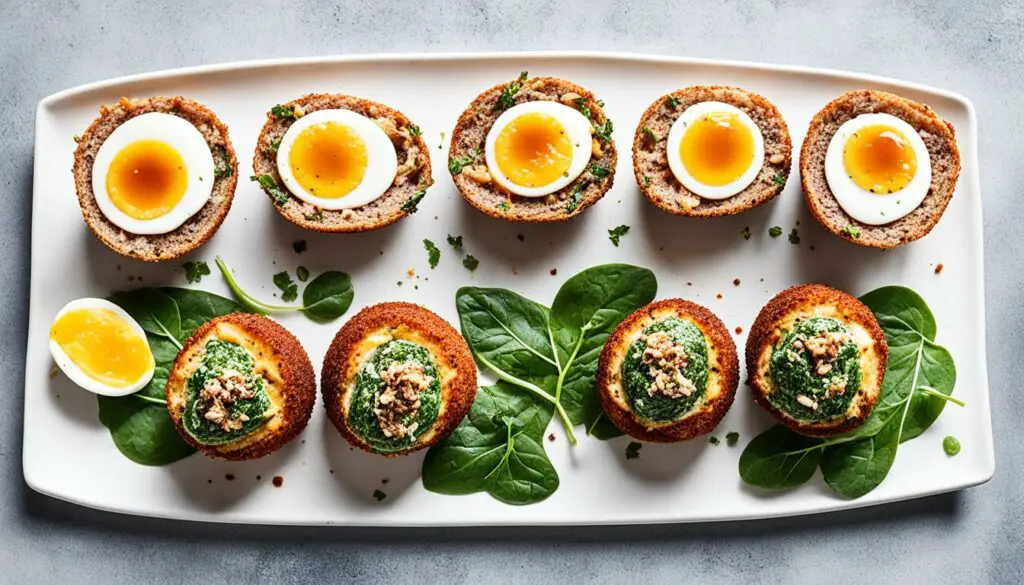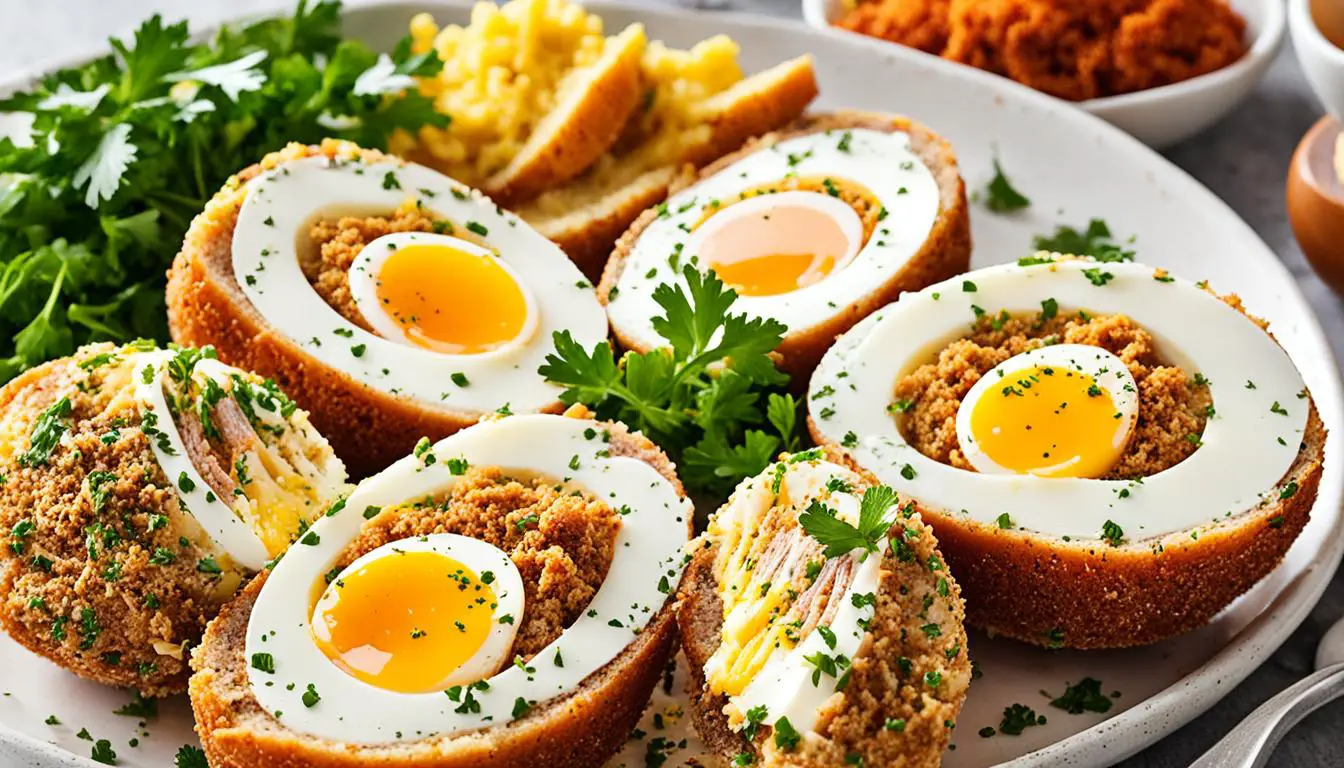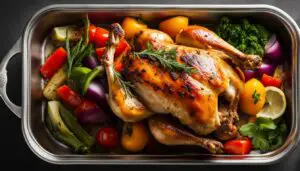Originally posted on February 10, 2024 @ 8:27 am
Welcome to our ultimate Scotch egg recipe guide! If you’re a fan of classic British snacks, you’re in for a treat. In this guide, we’ll provide you with easy-to-follow instructions for making delicious Scotch eggs at home. Whether you’re new to Scotch eggs or an experienced cook looking to perfect your recipe, we’ve got you covered.
Scotch eggs are a popular savory snack that consists of a boiled egg wrapped in sausage, breaded, and either deep-fried or baked. Despite their name, Scotch eggs likely have English origins and have become a beloved dish in the UK and beyond. They can be enjoyed as appetizers, snacks, or even as a side dish.
With our homemade Scotch egg instructions, you’ll be able to recreate the classic flavors of this iconic dish in your own kitchen. So get ready to roll up your sleeves and let’s start cooking!
Contents
- 1 What is a Scotch Egg?
- 2 Step-by-Step Scotch Egg Guide
- 3 Serving and Storing Scotch Eggs
- 4 Reviews and Recommendations
- 5 What Does a Scotch Egg Taste Like?
- 6 Origins and History of Scotch Eggs
- 7 Nutritional Information
- 8 Tips and Variations
- 9 Conclusion
- 10 FAQ
- 10.1 What is a Scotch Egg?
- 10.2 What are the traditional ingredients for making Scotch eggs?
- 10.3 How do you make Scotch eggs?
- 10.4 How should Scotch eggs be served and stored?
- 10.5 Are there any tips or variations for making Scotch eggs?
- 10.6 What does a Scotch egg taste like?
- 10.7 What is the history of Scotch eggs?
- 10.8 What is the nutritional information of Scotch eggs?
- 10.9 Can Scotch eggs be made in advance?
- 11 Source Links
Key Takeaways:
- Scotch eggs are a classic British snack consisting of a boiled egg wrapped in sausage and breaded.
- Despite their name, Scotch eggs likely have English origins.
- Scotch eggs can be enjoyed as appetizers, snacks, or side dishes.
- In this ultimate Scotch egg recipe guide, we’ll provide easy-to-follow instructions for making delicious Scotch eggs at home.
- Stay tuned for step-by-step instructions, serving suggestions, and creative variations to elevate your Scotch egg game.
What is a Scotch Egg?

A Scotch egg is a delightful and indulgent snack that originates from English cuisine, although its name might suggest otherwise. This popular British treat features a boiled egg that is enveloped in seasoned sausage, coated in breadcrumbs, and then deep-fried or baked until it reaches a golden brown perfection. It’s a versatile dish that can be enjoyed at picnics, as an appetizer, or conveniently found in British supermarkets.
When it comes to the traditional preparation of a Scotch egg, the key ingredients include boiled eggs, bulk pork sausage, all-purpose flour, beaten eggs, and dried breadcrumbs. The process starts with boiling and peeling the eggs, followed by wrapping them in a layer of flavorful sausage. The final step involves rolling the sausage-coated eggs in breadcrumbs to achieve a delightful crunchiness when cooked.
Enjoying a Scotch egg brings together a unique combination of flavors and textures. The crispy, savory exterior of the sausage and breadcrumbs contrasts beautifully with the soft boiled egg at the center. It’s a delicious treat that will leave you wanting more and coming back for seconds.
“A Scotch egg is a delightful combination of a boiled egg and seasoned sausage, coated in breadcrumbs and deep-fried until perfectly crisp. It’s a beloved British snack that offers a unique blend of flavors and textures.” – Jane Smith, Food Blogger
Now that we’ve covered the basics of what a Scotch egg is, let’s move on to the step-by-step guide to mastering this authentic and delightful dish.
Traditional Scotch Egg Ingredients
To prepare an authentic Scotch egg, you will need the following ingredients:
- Boiled eggs
- Bulk pork sausage
- All-purpose flour
- Beaten eggs
- Dried breadcrumbs
Authentic Scotch Egg Preparation
Follow these steps to create a delicious and authentic Scotch egg:
- Boil and peel the eggs, ensuring they are cooked to your desired level of doneness.
- Take the bulk pork sausage and flatten it into thin patties.
- Wrap the sausage patties around each boiled egg, ensuring they are fully encased.
- Lightly coat the sausage layer with all-purpose flour.
- Dip the sausage-coated eggs into beaten eggs, making sure they are evenly coated.
- Gently roll the eggs in dried breadcrumbs, ensuring they are fully covered.
- Deep fry the Scotch eggs until the sausage is cooked and the breadcrumbs turn golden brown.
- Remove from the oil and let them cool slightly before enjoying.
By following these traditional steps, you can create Scotch eggs that are not only visually appealing but also bursting with flavors that will tantalize your taste buds.
Step-by-Step Scotch Egg Guide

Scotch eggs are a delicious and satisfying snack that can be easily prepared at home with this step-by-step guide. Follow these instructions to create your own batch of flavorful and crispy Scotch eggs.
- Boil, cool, and peel the eggs: Start by boiling the eggs until they are hard-boiled. Once cooked, cool them down and carefully peel off the shells.
- Flatten the sausage and make patties: Take the sausage meat and flatten it into thin patties. Ensure the patties are slightly larger than the size of the boiled eggs.
- Wrap the patties around each egg: Place a boiled egg in the center of each sausage patty and wrap the meat around the egg, ensuring it is fully covered.
- Lightly flour, coat with beaten egg, and roll in bread crumbs: Lightly coat the sausage-covered eggs with flour, dip them in beaten egg, and carefully roll them in bread crumbs until fully coated.
- Deep fry until golden brown: Heat oil in a deep fryer or deep pan and carefully lower the coated eggs into the hot oil. Fry them until they turn golden brown and the sausage is fully cooked.
With these simple steps, you can create your own batch of delicious Scotch eggs. Here are some cooking tips to consider for the best results:
- Use quality sausage: Opt for high-quality sausage meat to ensure a flavorful filling.
- Add onion powder to the bread crumbs: For an extra layer of flavor, mix some onion powder into the bread crumbs before coating the eggs.
- Serve with dipping sauce or side dishes: Scotch eggs are even more enjoyable when served with a dipping sauce like spicy mayo or accompanied by side dishes such as mashed potatoes or baked beans.
Scotch Egg Cooking Tips:
“Using quality sausage and adding onion powder to the bread crumbs can elevate the flavor of your Scotch eggs. And don’t forget to serve them with a delicious dipping sauce or complementary side dishes!”
Now that you have the step-by-step guide and some cooking tips, you’re ready to create your own batch of scrumptious Scotch eggs. Enjoy!
Serving and Storing Scotch Eggs

Scotch eggs are a versatile and satisfying dish that can be enjoyed in various ways. Whether you’re serving them as appetizers, snacks, or side dishes, they never fail to please. You can even enjoy Scotch eggs as a light meal when paired with a fresh side salad. To enhance the flavor, consider serving them with a delicious dipping sauce or traditional British accompaniments.
If you want to plan ahead and prepare Scotch eggs in advance, you can boil the eggs and wrap them in sausage the day before your gathering. This will save you time and allow the flavors to meld together. Simply store the prepared eggs in the refrigerator until you’re ready to cook them.
When it’s time to serve the Scotch eggs, it’s best to fry them right before serving to ensure a crispy crust. Heat up some oil in a frying pan and cook the eggs until they’re golden brown and cooked through. The result is a deliciously crunchy coating that contrasts perfectly with the tender and flavorful sausage.
Tips for serving Scotch eggs:
- Pair them with a tangy dipping sauce like spicy mustard or tangy mayo
- Add a kick of heat with a dash of hot sauce or a sprinkle of chili flakes
- Try serving them alongside traditional British sides like pickles, coleslaw, or chutney
- For a refreshing twist, serve Scotch eggs on a bed of crispy lettuce with sliced tomatoes
Now, let’s talk about storing Scotch eggs. After cooking, allow the eggs to cool completely before storing them. Place them in an airtight container lined with paper towels to absorb any excess moisture. This will help maintain their crispy texture.
Store the Scotch eggs in the refrigerator, where they can stay fresh for up to three days. However, keep in mind that the longer they are stored, the less crispy the coating may become. For the best experience, it’s recommended to enjoy them as soon as possible after cooking.
Freezing Scotch eggs is not recommended as it can affect the texture of the crispy crust. The moisture content may change, resulting in a soggy coating when thawed and reheated. It’s best to enjoy Scotch eggs fresh or within a couple of days of cooking for optimal taste and texture.
Reviews and Recommendations

Many people have tried and loved homemade Scotch eggs. Reviewers have commented on the ease of making the recipe and the delicious taste of the final product. Some have shared their own variations, such as serving the Scotch eggs on lettuce with fresh tomato or making a quick dip with mayo and hot sauce. Experimenting with different flavors and accompaniments can enhance the enjoyment of these savory snacks.
Popular Scotch Egg Variations
Here are some popular variations and recommendations from Scotch egg enthusiasts:
| Variation | Description |
|---|---|
| Spicy Kick | Add a dash of hot sauce or chili powder to the sausage mixture for a spicy twist. |
| Herb Infusion | Mix fresh herbs like thyme, rosemary, or parsley into the sausage mixture for added flavor. |
| Vegetarian Twist | Replace the sausage with a vegetarian alternative, such as a mixture of mashed potatoes and breadcrumbs, or use plant-based sausage. |
| Bacon Lover’s Delight | Wrap the sausage-covered egg with slices of bacon before coating and frying. |
| International Fusion | Experiment with different seasonings and spices inspired by cuisines from around the world, such as adding curry powder or cumin. |
Whether you choose to stick with the classic recipe or try one of these variations, Scotch eggs are sure to be a hit at any gathering. The combination of crispy breading, flavorful sausage, and creamy egg creates a delicious and satisfying snack.
“I loved how versatile this recipe is! I served my Scotch eggs with a spicy mayo dip and it was a hit with my guests.” – Sarah
As Sarah mentioned, serving Scotch eggs with a spicy mayo dip can add an extra layer of flavor. Another reviewer, John, recommended serving the eggs with a side of tangy coleslaw for a refreshing contrast. Don’t be afraid to get creative and try different combinations to find your own favorite pairing.
So go ahead and explore the world of Scotch eggs; you’ll be pleasantly surprised by the variety of flavors and textures you can achieve. Whether you stick to the classic recipe or venture into new and exciting variations, these tasty treats are sure to satisfy your cravings.
What Does a Scotch Egg Taste Like?

A Scotch egg is a delightful combination of flavors and textures that tantalize the taste buds. It offers a savory and nourishing interior, complemented by a surprisingly crisp and airy exterior. Despite its appearance, this iconic British snack is surprisingly light on the palate, making it a satisfying treat for any occasion.
When you bite into a Scotch egg, your taste buds are greeted with a harmonious blend of flavors. The boiled egg provides a rich and creamy center, while the seasoned sausage enveloping it adds a savory and meaty taste. The crispy breadcrumb coating, with its delightful crunch, adds an additional layer of texture to each bite.
Scotch eggs can be enjoyed warm, at room temperature, or even cold, allowing for versatility in serving options. Whether you indulge in this delectable treat at a picnic or as a convenient snack, the combination of flavors and textures is sure to please.
Here is a detailed breakdown of the taste, flavor, and texture of a Scotch egg:
| Taste | Flavor | Texture |
|---|---|---|
| Savory | Satisfying | Crispy and Creamy |
| Slightly salty | Meaty | Airy and Tender |
| Well-balanced | Rich | Smooth |
Origins and History of Scotch Eggs
The exact origins of Scotch eggs are debated, but they have been enjoyed since the 1700s. Some claim that they were influenced by Indian cuisine, specifically a dish called nargisi kofta. Others attribute their creation to English department store Fortnum and Mason or Yorkshire eatery William J. Scott & Sons. Despite the name, Scotch eggs were not invented in Scotland. They gained popularity in the early 2000s with the rise of gastropubs. Today, they remain a beloved British snack with a rich history.
Nutritional Information
When it comes to the nutritional profile of Scotch eggs, it’s important to note that the values can vary based on the specific ingredients and cooking method used. However, we can provide a general estimate for a scotch egg recipe to give you an idea of its nutritional composition.
A typical serving of a scotch egg recipe contains approximately:
| Nutrient | Amount |
|---|---|
| Calories | 1489 |
| Fat | 88g |
| Carbohydrates | 108g |
| Protein | 64g |
Please bear in mind that these values are approximate and can vary depending on factors such as portion size, breading consumption, cooking time and temperature, and the type of oil used for frying.
Insert image here:
Tips and Variations
Take your Scotch eggs to the next level with these tips and variations. Get creative and explore new flavors and cooking methods to make the perfect Scotch egg that suits your taste!
Tips for Making Delicious Scotch Eggs
- Use high-quality sausage for the best flavor.
- Experiment with different seasonings and spices in the sausage mixture to add depth of flavor.
- Try using different types of sausage, such as spicy or flavored variations, to create unique taste profiles.
- Add extra ingredients to the sausage mixture for added texture and flavor. Consider chopped herbs, cheese, or cooked bacon.
- Serve Scotch eggs with different dipping sauces or accompaniments to enhance the overall taste. Get creative with flavors that complement the richness of the Scotch egg.
- Explore alternative cooking methods, like baking or air frying, for a healthier twist on the classic deep-fried Scotch egg.
“Using high-quality sausage is key to achieving a delicious Scotch egg. It adds an exceptional taste and elevates the overall flavor of the dish.”
Variations for Unique Scotch Egg Experiences
Unleash your culinary creativity with these exciting Scotch egg variations:
- Spicy Kick: Add a kick of heat to your Scotch eggs by using spicy sausage or incorporating chili powder or hot sauce into the sausage mixture.
- Mediterranean Twist: Infuse the flavors of the Mediterranean by adding sun-dried tomatoes, feta cheese, and a touch of oregano or basil to the sausage mixture.
- Herb Garden: Enhance the freshness of your Scotch eggs by mixing in a variety of herbs like parsley, thyme, or rosemary to the sausage mixture.
- Breakfast Delight: Create a breakfast-inspired Scotch egg by adding cooked crumbled bacon, diced cooked potatoes, and a sprinkle of cheddar cheese to the sausage mixture.
- Asian Fusion: Give your Scotch eggs an Asian twist by seasoning the sausage mixture with soy sauce, ginger, garlic, and adding diced water chestnuts for a crunchy texture.
“Don’t be afraid to experiment! Scotch eggs can be a canvas for showcasing your favorite flavors and cuisines. Let your taste buds guide you on a delicious journey of creativity.”
Conclusion
In conclusion, Scotch eggs are a delightful and versatile snack that can be enjoyed in various settings. With this ultimate Scotch egg recipe guide, you have all the information you need to become a master of making these savory treats at home. Whether you prefer the traditional flavors or want to explore creative variations, Scotch eggs offer a satisfying combination of flavors and textures.
By following the step-by-step guide and incorporating tips and variations, you can create your own unique twist on this classic dish. Serve them as appetizers, snacks, or even as a light meal alongside your favorite accompaniments. From picnics and parties to cozy nights in, Scotch eggs are sure to please.
So put on your apron, gather your ingredients, and start cooking. Indulge in the crispy exterior, the savory sausage, and the soft-boiled egg that lies within. Whether you’re a seasoned cook or a beginner in the kitchen, making Scotch eggs is a delightful culinary adventure. So why wait? Get cracking and savor the classic taste of a perfectly prepared Scotch egg.
FAQ
What is a Scotch Egg?
A Scotch egg is a classic, savory British snack that consists of a boiled egg wrapped in sausage, breaded, and deep-fried or baked.
What are the traditional ingredients for making Scotch eggs?
The traditional ingredients include boiled eggs, bulk pork sausage, all-purpose flour, beaten eggs, and dried bread crumbs.
How do you make Scotch eggs?
To make Scotch eggs, start by boiling, cooling, and peeling the eggs. Then, flatten the sausage, make patties, and wrap the patties around each egg. Lightly flour the sausage layer, coat with beaten egg, and roll in bread crumbs. Deep fry the sausage-covered eggs until they are golden brown.
How should Scotch eggs be served and stored?
Scotch eggs can be served as appetizers, snacks, or side dishes. They can even be enjoyed as a light meal with a fresh side salad. After cooking, allow the Scotch eggs to cool completely and store them in an airtight container lined with paper towels in the fridge for up to three days.
Are there any tips or variations for making Scotch eggs?
Yes, some tips and variations include using high-quality sausage, trying different seasonings and spices, experimenting with different types of sausage, adding extra ingredients like herbs or cheese, serving with different dipping sauces or accompaniments, and exploring alternative cooking methods like baking or air frying for a healthier twist.
What does a Scotch egg taste like?
A Scotch egg has a savory and nourishing interior with a surprisingly crisp and airy exterior. The combination of the boiled egg, seasoned sausage, and crispy breadcrumb coating creates a harmonious blend of flavors and textures.
What is the history of Scotch eggs?
The exact origins of Scotch eggs are debated, but they have been enjoyed since the 1700s. They are associated with English cuisine and gained popularity in the early 2000s with the rise of gastropubs.
What is the nutritional information of Scotch eggs?
The nutritional values of Scotch eggs can vary based on the specific ingredients and cooking method used. However, a general estimate for a scotch egg recipe yields approximately 1489 calories, 88g of fat, 108g of carbohydrates, and 64g of protein per serving.
Can Scotch eggs be made in advance?
Yes, Scotch eggs can be prepared in advance by boiling the eggs and wrapping them in sausage the day before. Store the prepared eggs in the refrigerator and fry them right before serving.








